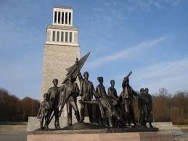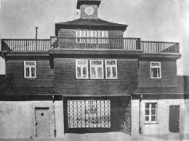Buchenwald was a concentration camp run by the Nazis during World War II, later used by the Soviets as a camp for political enemies of the USSR. Built in 1937 very near Weimar, Germany, it was one of the earlier camps built by the Nazis and held prisoner a wide range of innocents, men and women alike, who were incarcerated on the basis of race, religion, sexual orientation, disability, political persuasion , or for being an enemy soldier. There were a vast number of Soviet prisoners held and murdered at Buchenwald. In memoriam to the many whose bodies were cast into unmarked or mass graves in the surrounding forest, there stand today slender long stakes amongst the trees, the number a rough estimate of the number of Soviet remains buried there. The stakes are not decorated in any way, nor personalized. They are stark and uniform, perhaps highlighting the methodically diabolical way in which they these people were killed, or perhaps only because there is no way of knowing who is buried where. In addition to these markers, there is a memorial to all those buried in mass graves: the Jews, homosexuals, communists, pacifists, political dissidents, and the disabled. Not far from the main area of Buchenwald an immense tower stands in a clearing. It is made entirely of stone. Extending out from it, one can walk down stone steps, also quite expansive, and continue down a path, passing stone columns, one for each country that suffered losses of innocent lives. Everything at this memorial is gigantic. It makes everything around it appear small, the trees, the people, nothing can compare to the masses of stone, as if to point out the magnitude of lives lost, the intensity and the horrifyingly singular nature of the crimes brought against humanity by the Nazis.
, or for being an enemy soldier. There were a vast number of Soviet prisoners held and murdered at Buchenwald. In memoriam to the many whose bodies were cast into unmarked or mass graves in the surrounding forest, there stand today slender long stakes amongst the trees, the number a rough estimate of the number of Soviet remains buried there. The stakes are not decorated in any way, nor personalized. They are stark and uniform, perhaps highlighting the methodically diabolical way in which they these people were killed, or perhaps only because there is no way of knowing who is buried where. In addition to these markers, there is a memorial to all those buried in mass graves: the Jews, homosexuals, communists, pacifists, political dissidents, and the disabled. Not far from the main area of Buchenwald an immense tower stands in a clearing. It is made entirely of stone. Extending out from it, one can walk down stone steps, also quite expansive, and continue down a path, passing stone columns, one for each country that suffered losses of innocent lives. Everything at this memorial is gigantic. It makes everything around it appear small, the trees, the people, nothing can compare to the masses of stone, as if to point out the magnitude of lives lost, the intensity and the horrifyingly singular nature of the crimes brought against humanity by the Nazis.
Both the metaphorical and the literal presumptions serve only to make these memorials more wrenching. The families of these people were not only robbed of the life of their loved ones, but even in death, there is no one specific place to go to pay their respects. The individual is replaced with the masses. There is no unique place for every person, just one place for a lot of people. They remain lost in limbo with only the cruel, and in all probability, vain hope that perhaps they made an escape, that there was a mistake in the orderly ledgers of their captors if their names even made it into one at all.

The most horrifying juxtaposition and realization came from the surrounding landscape. The camp itself was gray and windy, cold and barren like a frozen-over remnant of Hell, the historical knowledge of which did nothing to alleviate the horrific feel to the place. Off in the distance, outside the parameters of the camp however, there were green mountains and little farmhouses, an errant church steeple, made all the more picturesque by their vague lack of detail and the ethereal glow of sun and far off precipitation. It was beautiful, making the camp all the more gruesome in comparison. It must have been almost a mockery to the prisoners suffering in the camp, to see in the distance freedom and beauty, and to realize that, in a place so near to their own prison, others were carrying on with their lives, experiencing only the inconveniences that come with being in a land at a time of war, as opposed to the soul crushing labor, the daily deaths, murders, torments, tortures and indecencies that were promulgated by the SS. In most places it is easy to lose perspective or to feel apathetic about the world and the people in it. But not at Buchenwald.

